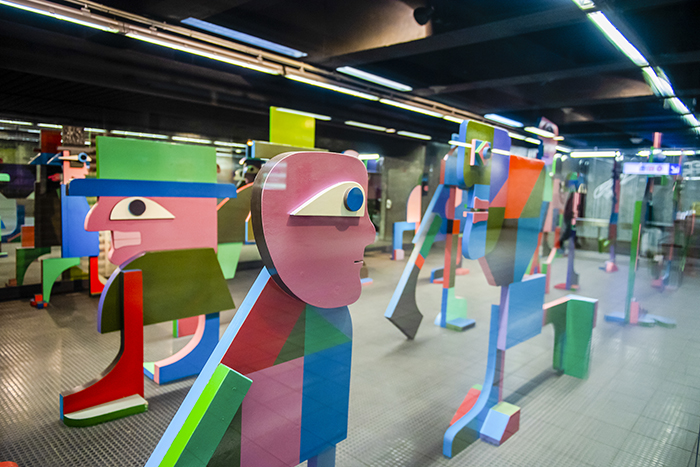21 sculptures in multicoloured wood (1980)
The artist represents the passenger who comes out of the ground in the morning and returns there in the evening: this creates a continuous coming and going, a crowd that swells like a tide and then returns when its job is done. He also wanted to represent the “different” passenger, the dreamer in the metro who doesn’t know exactly why he or she is there but who will perhaps identify with one of the characters. The group of statues is represented on a background of mirrors, so that the passenger can participate in the work of art: through the mirrors we have the impression that there are more characters present. The 21 figures are mostly represented in profile and each one has a very different appearance. The eyes are strongly accentuated. The eyes, mouths, moustaches, arms and legs are emphasised and are rendered in different colours. Above all, Pierre Caille is addressing the dreamers, the passers-by who still have a little imagination in this realist world.
List of links
PIERRE CAILLE (1912 – 1996)
Pierre Caille played a pioneering role in the development of ceramic sculpture in Belgium. He quickly mastered the techniques for pottery, glazed earthenware, enamel and stoneware, with which he discovered the shapes and colours which would lead to his “potter-painter” style, in which people from different countries appear naïve and innocent. This is because he represents the motifs schematically. He also adapts this natural aspect of his work for the theatre, for which he has designed décors and costumes. Pierre Caille was the first to set up a complete ceramics workshop in Belgium, at the Ecole Nationale Supérieure d’Architecture et des Arts Visuels de La Cambre. In this way he influenced many generations of young artists. Ceramics remained the most important art form for Pierre Caille, but this did not stop him from experimenting with sculptures in bronze, collages, sculptures in lacquered wood, paintings and jewellery.
PICTURE

 Twitter
Twitter